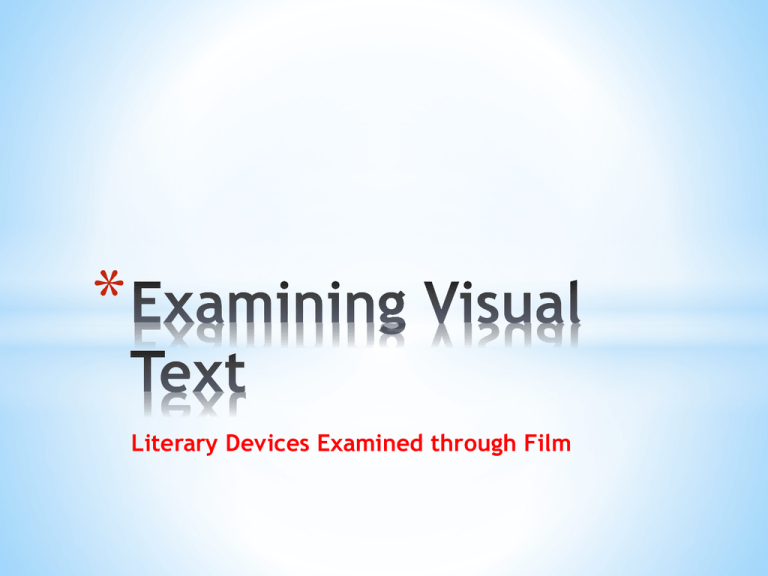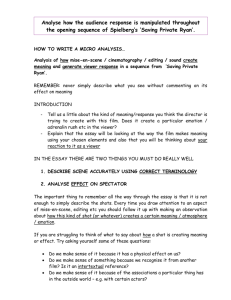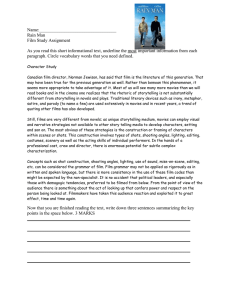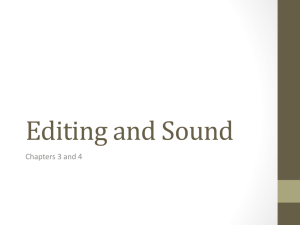Examining Visual Text
advertisement

* Literary Devices Examined through Film “Books and movies are like apples and oranges. They both are fruit, but taste completely different.” --Stephen King. Author *LONG SHOT (LS): a shot from some distance. If filming a person, the full body is shown. It may show the isolation or vulnerability of the character (also called a FULL SHOT). *MEDIUM SHOT (MS): the most common shot. The camera seems to be a medium distance from the object from the waist up. The effect is to ground the story. *CLOSE-UP (CU): the image being shot takes up at least 80 percent of the frame. * *EYE LEVEL: a shot taken from a normal height, i.e., the character’s eye level; 90 to 95 percent of the shots seen are eye level because it is the most natural angle. *HIGH ANGLE: camera is above the subject. This usually has the effect of making the subject look smaller than normal, giving him/her the appearance of being weak, powerless, and trapped. *LOW ANGLE: camera shoots subject from below. This usually has the effect of making the subject look larger than normal, therefore strong, powerful, and threatening * *HIGH KEY LIGHTING: scene is flooded with light, creating a bright and open-looking scene. *LOW KEY LIGHTING: scene is flooded with shadows and darkness, creating suspense or suspicions. *DIEGETIC SOUND: sound that would be logically heard by the characters in the film. *NON-DIEGETIC: sound that could not be heard by characters in the film, but is designed for audience reaction. An example might be ominous music for foreshadowing. * * CROSS CUTTING: cut into action that is happening simultaneously. * POINT OF VIEW: shows what things look like from the perspective of someone or something in the scene. It must be juxtaposed with shots of the actor’s face in order to make a connection with the viewer. * *ELACC10RL5: Analyze how an author’s choices concerning how to structure a text, order events within it (e.g., parallel plots), and manipulate time (e.g., pacing, flashbacks) create such effects as mystery, tension, or surprise. * Film Clip #1: The Fast and the Furious (2001) * “Reading” Purpose: ①Notice what you notice. ②How does the director manipulate time and why? ③How does the director create tension and suspense? http://www.youtube.com/watch?v=nfV87TgYH78 Film Clip #2: Schindler’s List (1993) * “Reading” Purpose ① Notice what you notice. ② Why did the director use primarily a long shot? ③ How do the events seem to affect Schindler and Ingrid? ④ Describe the sounds heard in the scene. What is the effect of these sounds? http://www.bing.com/videos/search?q=movie+clips+28b+schindler%27s+list+movie+the+girl+ in+red&qpvt=movieclips.com%2f2o8b-schindlers-list-movie-the-girl-inred%2f&form=vdre&ibss=1#view=detail&mid=52DAD1004D51F5EEFC6352DAD1004D51F5EEFC6 3 *Film Clip #3: Good Morning Vietnam (1987) *“Reading” Purpose: Read the lyrics of It’s a Wonderful World by Louis Armstrong ①Describe the visual pictures that might correspond to the song. ②Describe the emotions evoked while watching this scene. ③Define irony and its effect while watching the clip with sound. https://www.youtube.com/watch?v=FtX3lPf084U *ELACC10RL2: Analyze in detail the development of theme over the course of the text, including how it emerges and is shaped and refined by specific details. Film Clip #4: Philadelphia (1993) *“Reading” Purpose: ① Notice what you notice. ② How does the director communicate that Tom Hanks’s character is the outsider? ③ How does the director characterize… a) Denzel Washington’s character? b) Tom Hanks’s character? https://play.google.com/store/movies/details/Philadelphia?id=m139_i2tCc Q&hl=en ① What common elements exist when analyzing both print and visual text? ② How do print and visual text differ in the techniques used to appeal to the reader or viewer’s emotions? ③ What drawbacks exist in both print and visual storytelling? ④ What techniques do visual and print text use to develop characters? *






